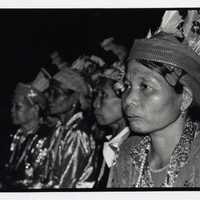Taba' Manjaratun (Gawai Mamandung)
Item
- Archivist's Original Title
- Original description
- Time duration
- Recording date of the original material
- Acquisition Date
- Population
- Place of the cultural origin
- Country Name
- Recording place
- Resource Language
- Comment
- Archivist Category
- Recording context
- Collector
- Name of original Collection
- Collection source citation
- Related material
- External reference
- History of ownership
- Holding Institution of Original Materials
- Licensing Institution
- Accessing Institutions
- Copyright Information
- Copyright Notice
- Physical format
- Preservation State of Physical Object
- Original item number
- SEAH Identifier
-
en
Taba' Manjaratun (Gawai Mamandung)
-
fr
Taba' Manjaratun (Gawai Mamandung), frappe d’accueil
-
id
Taba' Manjaratun (Gawai Mamandung)
-
en
Field recordings made in West Kalimantan, Indonesia, in 1997 by D. Rappoport :Dayak, Iban, Kayan populations.
-
fr
Enregistrements sonores inédits réalisés en Indonésie (West Kalimantan) en 1997 par Dana Rappoport, auprès des populations Dayak Taman, Iban, Kayan Mendalam.
-
id
Rekaman dibuat di Indonesia (Kalimantan Barat) pada tahun 1997 oleh Dana Rappoport, dalam masyarakat Mendalam Dayak Taman, Iban, Kayan.
-
en
00:04:27
-
en
1997-08-07
-
en
2011
-
en
Dayak Taman
-
en
Kampung Lunsa Hilir, kecamatan Putussibau, kabupaten Kapuas ulu, Kalimantan
-
en
Taman
-
en
1st day of a six-day ritual (Gawai Mamandung). This day is called Bumbulan. It precedes the construction of cow cages (maniang pandung). Women seated Chanting in the long house, the men face them. Before going down to build the cages (pandung), they perform in the long house. They serve for drinks.also called taba' rami-rami (animated). reception rhythm. Composition: kangkuang slot drum, tuung cylindrical drum, 3 tawak hanging gongs, 3 babandi hanging gongs, 1 set of gongs on galentang frame. The tawaks play in reverse. 1/1/1/22. The third follows the second in reverse. major instrumental kangkuang.
The intro and conclusion of the strike are done with percussion (kangkuang + tuung) in a loop three times
Here the kangkuang slit drum is not present enough, the sound of the tawak is too muffled
-
fr
1er jour d'un rituel de six jours (gawai mamandung). Ce jour est appelé bumbulan. Précède la construction des cages à vaches (maniang pandung). Des femmes assises psalmodient dans la grande maison, les hommes leur font face. Avant de descendre construire les cages (pandung), ils jouent dans la grande maison. Ils servent à boire.Appelé aussi taba' rami-rami (animé). rythme d'accueil. Composition: tambour à fente kangkuang, tambour cyclindrique tuung, 3 gongs suspendus tawak, 3 gongs suspendus babandi, 1 jeu de gongs sur cadre galentang. Les tawak jouent en inversé. 1/1/1/22. Le troisième suit le second en inversé. instrum majeurkangkuang.
L'intro et la conclu de la frappe se font aux percussions (kangkuang + tuung)en boucle à trois reprises
Ici le tambour à fente kangkuang n'est pas assez présent, le son des tawak est trop feutré
-
id
Hari pertama dari ritual enam hari (Gawai Mamandung). Hari ini disebut Bumbulan. Ini mendahului pembangunan kandang sapi (maniang pandung). Para wanita duduk melantunkan nyanyian di dalam rumah besar, sementara para pria menghadap ke arah mereka. Sebelum turun membangun kandang (pandung), mereka tampil di rumah panjang. Mereka menyajikan minuman.Dinamakan juga taba' rami-rami (animasi). ritme penerimaan. Dengan: gendang slot kangkuang, gendang tuung silinder, 3 buah gong gantung tawak, 3 buah gong gantung babandi, 1 set gong pada rangka galentang. Para tawak bermain terbalik. 1/1/1/22. Yang ketiga mengikuti yang kedua secara terbalik. kangkuang instrumental utama.
Intro dan penutup pemukulan dilakukan dengan perkusi (kangkuang+tuung) sebanyak tiga kali putaran
Disini kendang kangkuang kurang hadir, suara tawak terlalu teredam
-
en
Music (Vocal)
-
en
Field recording
-
en
Indonesia: West Kalimantan, 1997, D. Rappoport
-
en
RappoportPercussions des Taman, in revue Percussions, n° 59, vol IX/5, 1998.
-
en
Archived at CREM, CNRS in 2011 by D. Rappoport
-
In Copyright. Non-Commercial Use Permitted
-
For any use, please contact the CREM-LESC (CNRS, Nanterre University, France): crem.lesc[at]cnrs.fr ; See information at https://archives.crem-cnrs.fr
-
en
Digital Audio Tape
-
en
original
-
en
CNRSMH_I_2011_016_002_12
-
en
SEAH_CNRSMH_I_2011_016_002_12
- Media
 CNRSMH_I_2011_016_002_12
CNRSMH_I_2011_016_002_12




